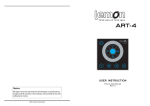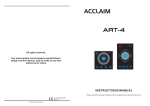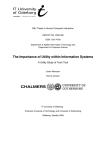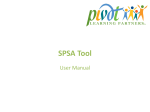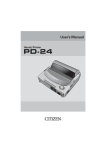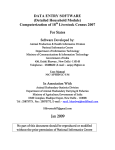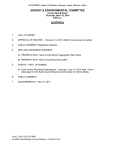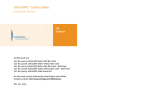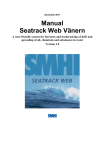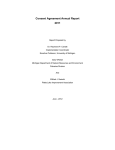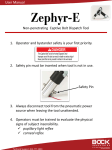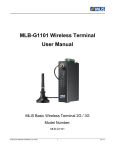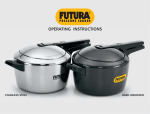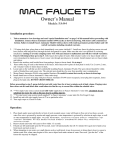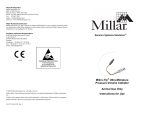Download Spartanburg Waters Grease Control Program
Transcript
Grease Control Program
The grease control program established by Spartanburg Water requires that fats, oils, and
greases be handled in a manner that does not cause sanitary sewer overflows or adversely
impact any component of Spartanburg Water’s sewer collection lines and/or wastewater
treatment system. This program requires that all food service establishments or any other
establishments that may impact our system with fats, oils, and greases comply with the
requirements set forth within this grease control policy. The intent of this program is to protect
the sanitary sewer system from the effects of fats, oils, and greases and to ensure that
compliance is maintained.
Section 1. Legal and Regulatory Basis
Pursuant to the authority of Act No. 1503 of 1970 as amended, general laws and statutes of the
State of South Carolina, and Federal law, the Spartanburg Sanitary Sewer District ("the District")
is empowered to establish rules and regulations. Act 1503 specifically authorizes the District to
“establish rules, regulations and policies related to the use, operation and administration of
sewerage facilities under the control of the Commission...”. The District is also empowered in
Act 1503 to establish such rules, regulations and policies related to "all sewerage facilities not
controlled by the District but from which sewerage is contributed to the District's system". Act
1503 empowers the District's Commission to "promulgate and publish such rules and
regulations as it may deem appropriate and necessary...".
The requirements within this policy include items referenced within the Spartanburg Sanitary
Sewer Use Rules and Regulations. The provisions in these Rules and Regulations (R&R) are
non-exclusive and the District may rely on other rules, regulations, statues, and policies
developed which are applicable.
Section 2. Prohibition Related to Oil & Grease Discharge
No person shall discharge or cause to be discharged any of the following described water or
wastes either directly or indirectly into the sewerage facilities of the District:
2.1. Total fats, wax, grease, or oil of animal or vegetable origin greater 100 mg/l, whether
emulsified or not, or containing substances which may solidify or become viscous at a
temperature between 32 and 160 Fahrenheit (0 and 71.1 Celsius) unless otherwise
approved or permitted in writing.
2.2. Any substance which will cause interference; i.e., contribute to the treatment plant
violating its NPDES Permit or the water quality standards of the receiving stream or any other
federal or state permit regulating the operation of the treatment plant.
2.3. Pollutants in any quantity that may result in a sheen, foam, or color on the receiving
stream.
2.4. Any trucked or hauled pollutants or wastewater except as specifically authorized by the
District.
1
2.5. Petroleum oil, non-biodegradable cutting oil, or products of mineral oil origin, in amounts
that may cause interference or pass through.
2.6 The use of chemical or biological agents, physical methods, or any other means to
dissolve, liquefy, suspend, disperse, emulsify, entrain, or otherwise cause any oil, grease, or
other similar material to flow through the sewer sanitary sewers or achieve compliance with the
District limitations.
If the District determines to its satisfaction, that any prohibited discharge has taken place, the
District shall employ whatever enforcement actions it deems necessary.
Section 3. Definitions
3.1. District
The Spartanburg Sanitary Sewer District, Spartanburg, South Carolina, or any duly
authorized officials acting in its behalf.
3.2. Fats, oils and grease
Oil and grease includes non-volatile hydrocarbons, vegetable oils, animal fats, waxes,
soaps, greases, and related pollutants that can be extracted from a wastewater sample and
determined by EPA method 1664 as may be amended or by other EPA method as may be
applicable; oil and grease is also referred to as n-hexane extractable materials (HEM) because
of the solvent used in the method’s extraction process. Discharge of oil and grease into the
POTW is conditionally permitted as indicated in Section 3 of the Spartanburg Sanitary Use
Rules and Regulations.
3.3. Food Service Establishment (FSE)
Any facility that prepares and or serves food for consumptions and discharges kitchen or
food preparation wastewater including restaurants, institutes, motels, hotels, cafeterias,
hospitals, schools, bars, bakeries, meat processing operations etc., and any other facility that, in
Spartanburg Sanitary Sewer District’s opinion would require a grease trap installation by virtue
of its operations. Such definition normally includes any establishment required to have a South
Carolina Department of Health and Environmental Control (SCDHEC) food service license and
any like agency in bordering states which discharges impacts Spartanburg Sanitary Sewer
District’s service area.
FSE excludes residential occupancies that do not participate in the selling or preparation
of food for commercial gain or business.
3.4. Grease Trap/Grease Interceptor
The device utilized to effect the separation of fats, oils and greases in wastewater
effluents from food service establishments and/or grease and oil generating establishments
(vehicular repair/maintenance centers). Such traps or interceptors may be of the “outdoor” or
underground type normally of a 1,000 gallons capacity or greater capacity, or the “under-thecounter” package units normally referred to as the under-the-counter. Please note that underthe-counter traps require special approval from the District for installation. For the
purpose of this Program, the words “trap” and “interceptor” are generally used interchangeably.
The device used should maintain oil and grease effluent not to exceed 100 mg/l as stipulated
within the Rules and Regulations.
3.5. Oil Water Separator
An in-line device utilized to remove oils and greases from wastewater effluents from
vehicular service activities. The device used should maintain an oil and grease effluent not to
exceed 100 mg/l as stipulated within the Rules and Regulations.
2
3.6. Sand Traps
A device utilized to trap sand, rocks, and similar debris heavier than water. This device
may be installed in outlets from car wash areas also referred to as a grit trap.
3.7. 25% Rule
Grease traps have been found not to operate consistently well when at a capacity of
25% or more with oils, greases and/or solids; therefore it is the District’s policy that these units
should be serviced once 25% of the liquid height of the grease trap contains floating materials,
solids, oils and/or greases.
3.8. User
Any person who contributes, causes, or permits the contribution of wastewater into
Spartanburg Sanitary Sewer District.
Section 4. Requirements For Oil And Grease Traps or Interceptors
District approved grease, oil and sand traps or interceptors are required and necessary for all
existing and new food service establishments or operations, vehicular service facilities, and car
washes for the proper handling and control of wastewater containing grease, oil or sand being
discharged to public sanitary sewers in excessive amounts. Such traps or interceptors shall not
be required for private living quarters or dwelling units, but may be required for industrial or
commercial establishments, public eating places, hospitals, dependent care facilities, hotels,
abattoirs, or other institutions. Such traps or interceptors shall be readily accessible for cleaning
and inspection and shall be maintained by the owner/user at his expense and in continuous
operation. Whenever District or subdistrict inspection of such existing traps or interceptors
results in a written notice for action on the part of the person responsible for the trap or
interceptor, such action shall be completed within the compliance period granted by the
inspecting authority.
When retained or trapped material (including but not limited to oil, grease, sand, grit, etc.) is
removed from grease, oil and sand traps or interceptors, such material shall be removed by
pumping or other physical means and shall be hauled away for disposal in accordance with
applicable federal, state, and local regulations. No such retained or trapped material in any
form shall be allowed to pass from the trap or interceptor into the sanitary sewer. The entire
contents of the grease trap must be removed, this includes all trapped fats, oils, and greases,
wastewater therein and solids. No waste, and/or wastewater from the pumping are to be
reintroduced into the grease trap/grease interceptor. The use of chemical or biological agents,
physical methods, or any other means to dissolve, liquefy, suspend, disperse, emulsify, entrain,
or otherwise cause retained or trapped material to flow from the trap or interceptor into the
sewer collection system are prohibited. No wastewater, with the exception of wastewater
generated and related to food preparation shall be introduced to a grease trap. The owner/user
shall provide the District, upon request, with accurate information as to the ultimate disposal
method and location of the material pumped or otherwise removed from the trap or interceptor.
Section 5. The District requires no less than a 1000 gallons in-ground outside grease
trap for the following:
5.1. A new building containing a food service establishment FSE.
5.2. A FSE placed in an existing building, which has not previously contained a FSE.
5.3. A major remodeling to occur at an existing FSE or a building that will be used for a FSE,
and where no outside grease trap is currently present.
3
5.4. Any FSE and/or commercial establishment that has been found to be the cause of one or
more fat, oil and grease overflows, or has been found to have a discharge that requires the
District to increase maintenance to prevent fat, oil and grease-related line blockages and/or
overflows from occurring.
5.5. Churches containing schools and/or that routinely prepare and serve food.
If a1000 gallon grease trap is found to be inadequate and the discharge results in problems
within the District sewer line collection system, Spartanburg may revisit this installation and
require improvements as deemed necessary.
FSE excludes residential occupancies that do not participate in the selling or preparation of food
for commercial gain or business. At its discretion, the District may exclude sandwich shops
without fryers, coffee shops, frozen dairy product shops or others if deemed non-significant.
Section 6. Commercial Development Recommendations
Spartanburg Water recommends that new commercial developments provide a stub-out for a
separate waste collection lines for the installation of future in-ground outside grease trap(s) for
each potential unit within a commercial development. The owner/user of a new commercial
development should account for suitable physical property space and sewer gradient that will be
conducive for the installation of an outside, in-ground grease trap(s) for any flex space
contained within the commercial development. Physical property restrictions and sewer
gradient should not be a hindrance for the installation of an in-ground outside grease trap.
Section 7. Variances
7.1. Variances to the design and maintenance requirements contained herein may be
requested. The User must submit sufficient documentation as required by the Spartanburg
Water General Manager or his/her designee that explains the need to vary from design or
maintenance requirements. The District will notify in writing of the acceptance or denial of the
variance request. The District reserves the right to revoke the variance when deemed
necessary.
7.2. Any FSE allowed to have a variance to this policy must adopt the Best Management
Practices. The Best Management Practices can be found at the end of this document. FSE
should have a waste bin on site for the shipment of grease and/or grease laden waste for offsite
disposal.
7.3. Where it is determined by the District that the installation of an approved in-ground outside
grease trap is infeasible or physically impossible to install, then an adequate and approved
“under-the-counter” grease trap, may be required for use on individual fixtures, including sinks,
dishwashers, and other potentially grease containing drains. The location of these units must be
located as near as possible to the source of the wastewater. Under-the-counter grease traps
require more frequent maintenance and record-keeping.
Section 8. Compliance Timeframe for Installation of Grease Traps
Spartanburg Water acknowledges the cost associated with installing equipment at existing
facilities where no fats, oils and grease handling equipment is currently in place to comply with
the Grease Control Program Policy. Due to the cost associated with the installation of an inground outside grease trap for a FSE/Commercial establishment that must comply with the
requirements contained within this policy, the FSE/Commercial establishment will be given a
compliance deadline to complete the installation of the minimum 1000 gallons or greater grease
trap. The owner(s)/user(s) will be notified in writing and given 24 months from the date of
4
notification to have installed all proper equipment to ensure the requirements contained in this
policy are met. Failure to comply with this specified timeframe will be considered a violation of
this policy and may result in penalties, corrective actions and potential discontinuation of sewer
service.
If an existing FSE/Commercial establishment is found to have installed equipment that has been
determined to be inadequate or substandard to meet the requirements of this policy, the
owner(s)/user(s) will be notified in writing and given 12 months from the date of notification to
have installed all proper equipment to ensure the requirements contained in this policy are met.
Failure to comply with this specified timeframe will be considered a violation of this policy and
may result in penalties, corrective actions and potential discontinuation of sewer service.
If an FSE/Commercial establishment is required to install an under-the-counter grease trap, the
owner(s)/user(s) will be notified in writing and given 6 months from the date of notification to
have installed all proper equipment to ensure the requirements contained in this policy are met.
Failure to comply with this specified timeframe will be considered a violation of this policy and
may result in penalties, corrective actions and potential discontinuation of sewer service.
If the specified timeframe cannot be met, the FSE/Commercial establishment should request a
variance to the specified timeframe in writing at least 30 days prior to deadline given for
compliance. The number of variance request to the specified timeframe may be limited. This
variance request should be submitted:
Spartanburg Water
Industrial Wastewater - Grease Control Program
P.O. Box 251
Spartanburg, SC 29304
Section 9. Right of Entry
The District, DHEC, and EPA shall have the right to enter the premises of any user and locate,
inspect, photograph, videotape, or electronically image any sanitary sewer, facility, equipment,
process, event, or activity for the purpose of documenting compliance or noncompliance with
the Grease Control Program Policy and the Rules and Regulations or permit or as deemed
necessary for inspection or enforcement procedures. Use of photographs, videotapes or
electronic images by the District shall be consistent with the use of other information or reports
for the purposes of Section 1.3.14 of the Spartanburg Sanitary Sewer Use Rules and
Regulations. Users who wish to assert that photographs, video tapes or electronic images
constitute confidential information may do so in accordance with Section 1.3.14 of the
Spartanburg Sanitary Sewer Use Rules and Regulations. Users who deny or withdraw
permission for the District to photograph, videotape, or electronically image any facility,
equipment, process, event or activity shall be deemed to have denied entry.
Users shall allow the District ready access to all parts of the premises for the purposes of
location, inspection, sampling, records examination and copying, and the performance of any
additional duties. Any temporary or permanent obstruction to safe and easy access to the
facility to be inspected or sampled shall be promptly removed by the user at the request of the
District and shall not be replaced. The costs of clearing such access shall be borne by the user.
Where a user has security measures in force that require proper identification and clearance
before entry into its premises, the user shall make necessary arrangements with its security
guards so that, upon presentation of suitable identification, the District shall be permitted to
enter without delay for the purposes of documenting compliance or non-compliance or for
inspection or enforcement procedures. Unreasonable delays in allowing the District access to
the user’s premises shall be deemed a violation of the Grease Control Policy and the Rules and
Regulations.
5
The District shall have the right to set up on the user’s property, or require installation of, such
devices as are necessary to conduct sampling or metering of the user’s wastewater. The District
may require the user to install monitoring equipment as necessary. The facility’s sampling and
monitoring equipment shall be maintained at all times in a safe and proper operating condition
by the user at its own expense. All devices used to measure wastewater flow and quality shall
be calibrated no less frequently than annually to ensure their accuracy.
If the District makes a determination to discontinue a user’s sanitary sewer service in
accordance with the procedures in Section 6 of the Spartanburg Sanitary Sewer Use Rules and
Regulations, then the user or property owner shall allow the District ready and unobstructed
access to the user’s or property owner’s premises for the purpose of locating, inspecting,
disconnecting, or reconnecting the user’s sanitary sewer service.
Any user or property owner who denies entry to the District shall be subject to enforcement
actions including but not limited to penalties as described in this policy along with those
described Section 12 of the Spartanburg Sanitary Sewer Use Rules and Regulations, and other
penalties prescribed by law. If the District has been refused entry, and if the District suspects
that there may be a violation of the Grease Control Policy, the Rules and Regulations,
wastewater discharge permit, discharge authorization, or coverage under any general permit or
order, or the District has need to inspect as part of a routine inspection program of the District
designed to confirm compliance with this policy and/or the Rules and Regulations, wastewater
discharge permit, discharge authorization, or any order issued hereunder, or to protect the
overall public health, safety and welfare of the community, the District may seek an ex parte
order from the Court of Common Pleas directing that the user permit such access and may
obtain the services of the Sheriff of Spartanburg County to enforce such order.
Section 10. Frequency of Inspections by the District
10.1. In-ground Outside Grease Traps/Oil Water Separator
Users with in-ground outside grease traps/oil water separators will be inspected on routine basis
by District personnel. This inspection may include an inspection of the grease trap,
maintenance records, and grease/rendering bin(s). If non-compliance is found, the inspector
will leave a notice of non-compliance stipulating the item(s) that are found to be non-compliant
along with a specified timeframe for the user to become compliant. Failure to comply within the
specified timeframe may result in the District taking enforcement action against the user.
10.2. Under-the-Counter Grease Traps
FSEs with under-the-counter grease traps will be inspected at a minimum of semi-annual basis
by District personnel. This inspection may include an inspection of the grease trap,
maintenance records, and grease/rendering bins. If non-compliance is found, the inspector will
leave a notice of non-compliance stipulating the item(s) that are found to be non-compliant
along with a specified timeframe for the FSE to become compliant. Failure to comply within the
specified timeframe may result in the District taking enforcement action against the FSE.
Section 11. Standards for Construction In-ground Outside Grease Traps
In-ground outside grease traps shall be sized to provide at least a 25 minute retention time
under actual peak flow, with the exception of that no in-ground outside grease trap shall be less
than 1,000 gallons total capacity. All grease traps should receive a pre-installation approval
and a post installation approval from the District. To receive this approval contact the Grease
Control Program Coordinator at 864-253-9304 option 1 or at the email address:
[email protected], at least 36 hours in advance. A design drawing of the
grease trap to be installed, its plumbing details, and size should be submitted prior to the
installation along with the traps location in relation to the FSE it serves. Please note along with
6
this office, all grease traps drawings, designs, and installation plans require approval from the
city or county building code department(s) dependent on the jurisdiction the FSE may be
located. The City of Spartanburg and Spartanburg County utilize the International Plumbing
Codes.
All grease traps must be secured and maintained by its owner/user in a manner that will prevent
the introduction of any prohibited waste and any other unauthorized access. Owners/Users of
grease traps shall be responsible for all expenses related to securing their grease traps. The
failure to secure and maintain grease traps is a violation of the Spartanburg Sanitary Sewer
Rules and Regulations and enforcement actions may be taken against the FSE.
Typical construction-detail drawings are attached to this policy and can be found at:
http://www.sws-sssd.org/water-sewer/commercial/grease-control.php . In approving a FSE
grease trap installation, the District does not accept any liability for the failure of the grease trap
to meet and maintain compliance with this policy and/or the Rules and Regulations or any
subsequent regulation(s).
No grease trap may be greater than 2000 gallons, if more grease trap capacity is needed than
2000 gallons; an in-line series of traps of 2000 gallons or less may be utilized to comply with this
policy.
The approved materials, installation and construction detail for grease traps can be located in
Section 13 of the Spartanburg Water Technical Specifications for Sanitary Sewer Improvement,
Grease, Oil and Sand Traps or Interceptors.
In-ground outside grease traps (whether in single or in a series) must be accessible from the
surface and fitted with an influent tee that is at least 24 inches off the bottom and an final
effluent tee that is 12 inches off the bottom. Dual chambered grease traps must contain an
influent tee that is a least 24 inches off the bottom, a center clean-out above ground and a
dividing/baffle wall that is equipped with a tee that is 12 inches from the grease tank bottom on
the influent side and a pipe that goes through the dividing wall that is 24 inches off the bottom
on the effluent side of the tank. The effluent side final tee must be at least 12 inches off the
bottom.
These criteria apply to in-ground outside type grease trap units. All new traps should have an
accessible opening on the inlet side and one on the outlet side that is accessible for inspection
at all times. These openings should be typical load-bearing manhole covers unless otherwise
exempted by this office. All new food establishments should comply with these criteria. It is the
user’s responsibility to ensure accessibility to the trap located at the site, i.e. landscaping within
the trap area should not interfere with the accessibility. For much greater detail please refer to
Section 13 of Spartanburg Water’s Technical Specifications for Sanitary Sewer Improvements,
Grease, Oil and Sand Traps or Interceptors.
A guidance on the sizing of grease traps is located at the back of this document.
Section 12. Maintenance of In-ground Outside Grease Traps
Owners/users of a grease trap shall be responsible for the proper removal and disposal by
appropriate means of material captured by the grease trap.
The entire contents of the grease trap must be removed, this includes all trapped fats, oils and
greases, wastewater therein and solids. No waste, and/or wastewater from the pumping are to
be reintroduced into the grease trap/grease interceptor. Owners/users shall be responsible for
ensuring that no waste, wastewater or solids pumped from the trap is reintroduced back in the
trap or interceptor and that the trap is properly maintained.
7
The District requires that grease traps be serviced once 25% of the liquid height of the grease
trap contains floating materials, solids, oils and/or greases operating capacity has been
reached. The liquid height is measured as the internal depth from the outlet water elevation to
the bottom of the trap. This 25% capacity can be reached by the trap containing 25% of grease;
25% of solids; or a combination of grease and solids that reaches the 25%. The District
requires that all external traps be pumped on a consistent basis to ensure that the 25% capacity
is not violated. This may result in more frequent pumping than the required quarterly pumping
detailed below. The determination of when pumping is necessary should be determined by the
owner/user management in consultation with a contract hauler/pumper and based on the
condition of the trap. At a minimum, all in-ground outside grease traps must be pumped at least
once a quarter. Calendar quarters are defined as 1st quarter: January 1 through March 31;
2ndquarter: April 1 through June 30; 3rd quarter: July 1, through September 30; 4th quarter:
October 1, through December 31.
If a FSE/commercial establishment is found to have excessive non-compliance, and /or
continually impacts the District sewer system adversely, the District may deem it necessary to
regulate a FSE/commercial establishment by issuing a schedule to be followed which varies
from the above requirement. The District may also revisit this installation and require
improvements as it deems necessary.
12.1. Monitoring of Grease Traps for Polychlorinated Biphenyls (PCBs)
Any Introduction of Polychlorinated Biphenyls (PCBs) into the District’s sewer system or a
District’s reclaimed water facility is prohibited and is a violation of the Spartanburg Sanitary
Sewer Use Rules and Regulations and may result in enforcement action(s). The District will
secure monitoring for all in-ground outside grease traps within the District’s boundaries for
PCBs on an annual basis. A copy of the analysis will be forwarded to the FSE once received by
the District. Failure to maintain a secured grease trap is a violation of the Spartanburg Sanitary
Sewer Use Rules and Regulations and may result in enforcement action(s).
If PCBs are found, the District will take immediate steps to discontinue any discharge from the
FSE’s grease trap until the FSE can provide analytical results that demonstrate that the grease
trap has PCB levels of non-detect and PCBs are no longer present.
All FSEs with in-ground outside grease traps within Spartanburg County but outside of the
District’s boundaries will have to provide the District with laboratory reports and chain-ofcustodies from a SCDHEC certified laboratory to document that the grease trap contents have
no PCB contamination on an annual basis. The laboratory reports and all other required
paperwork must be presented prior to discharging the grease loads at a District owned
reclaimed water facility. Failure to provide this information may result in a denial of discharge.
12.2. Record-Keeping Requirement for In-ground Outside Grease Traps
Records should be maintained by the FSE owner/users documenting that proper grease
disposal has occurred or is occurring. It is the owner/users responsibility to educate their staff
on the proper disposal of kitchen waste without adversely impacting the sewer and how to
properly adhere to all record-keeping required as specified within this policy. All FSEs shall
maintain a copy of the Grease Trap Maintenance Log, a copy of the annual PCB Lab Report
results, and annual authorization letter from the District. These documents are to be accessible
and available to District personnel for review during inspections. Maintenance verification should
include the following: Copies of the Grease Trap Maintenance Log as well as the service receipt
from the Grease Hauler, PCB Lab Report results, and annual authorization letter from the
District. These records must be maintained for a minimum of one year.
8
The District’s Grease Trap Maintenance Log form must be utilized to document maintenance of
the grease trap. The records of pumping must be maintained by the grease trap owner/user for
no less than one year retention time and be available for review by the District upon request.
Section 13. Under-the-Counter Grease Trap Variance
Where in-ground outside grease traps are not feasible; special approval for an under-thecounter trap grease may be given provided that these devices are approved prior to installation.
To obtain prior approval, all necessary information must be supplied such as the kitchen
fixture(s) to which it will be attached, gallons per minute of discharge entering into the grease
trap unit, unit type, size, location, and flow control fittings, and any other information that may
deemed necessary by this office. Please note along with this office all grease traps drawings,
designs, and installation plans require approval from the city or county building code
department(s) dependent on the jurisdiction the FSE may be located. The City of Spartanburg
and Spartanburg County utilize the International Plumbing Codes. To receive approval, all the
above information should be submitted or mailed to this office 2 weeks prior to the installation.
A post-installation inspection will have to be performed by this office. To have the under-thecounter grease trap post-inspection performed; the Grease Control Program Coordinator should
be contacted at least 48 hours in advance at 864-253-9304 option 1, or at the email address:
[email protected] . In approving a FSE grease trap installation, the District
does not accept any liability for the failure of the grease trap to meet and maintain compliance
with this policy and/or the Rules and Regulations or any subsequent regulation(s).
An under-the-counter trap must be in close proximity to the source of the wastewater it receives.
All under-the-counter traps must be sized to prevent overloading of the trap and allow for proper
operation. This may be required on individual fixtures including dishwashers, sinks and other
potentially grease-containing drains. The sizing of the under-the-counter grease trap should be
based on the grease retention capacity rating in pounds. The District requires that this capacity
be at least two (2) times the GPM flow rate of the type fixture which it serves. An example is if
an under-the-counter trap is installed for a 50 gallon per minute sink, the trap should have the
grease retention capacity of 100 pounds. Flow control fittings must be provided to the inlet side
of the under-the-counter grease trap units to prevent overloading of the under-the-counter
grease trap and allow for proper operation. As stipulated, all the grease trap design and flow
control fitting must be approved by the District prior to installation.
A guidance on the sizing of grease traps is located at the back of this document.
13.1. Maintenance of Under-the-Counter Traps
Maintenance must occur weekly for under-the-counter grease traps. This requirement
may be changed if the District deems weekly to be inadequate or excessive for the particular
trap. A weekly form, Spartanburg Water Weekly Under-the-Counter Grease Trap
Disposal Log, can be found in this policy for maintenance of the under-the-counter grease
traps and should be utilized to document maintenance.
If a FSE/commercial establishment is found to have excessive non-compliance, and /or
continually impacts the District sewer system adversely, the District may deem it necessary to
regulate a FSE/commercial establishment by issuing a schedule to be followed which varies
from the above requirement. The District may also revisit this installation and require
improvements as it deems necessary.
13.2. Record-Keeping Requirement
Records should be maintained for review by the District’s inspector documenting that proper
disposal has occurred or is occurring. It is the owner/user responsibility to educate their staff on
9
the proper disposal of kitchen waste without adversely impacting the sewer and how to properly
adhere to all record-keeping specified within this policy.
The log sheet requires that the date, the amount removed, the method of disposal and the
manager’s signature be included on the form for each cleaning. The cleaning record should be
maintained on site for inspection by District personnel. The original forms should be maintained
by the grease trap owner/user for no less than one year retention time and be available for
review by The District.
Section 14. Non-compliance Enforcement and Penalties
14.1. Non-compliance violations with this policy are defined as but not limited to the following
items and/or any combination of these items:
Improper maintenance
Failure to maintain records
Failure to submit records
Inspection hindrance
Failure to pump grease
Failure to maintain necessary grease trap equipment (i.e. plumbing, covering, grease bin)
Source of sewer blockage
Source of sanitary sewer overflow
Falsification of maintenance Records
Failure to meet installation Compliance Timeframe
14.2. A Notification of Grease Trap Non-Compliance is issued whenever the District
inspector(s) finds that any of one or more policy violations have occurred. The inspector will
provide notification of the violation(s) to the FSE/commercial establishment owner/user or
management. This notification will typically include a timeframe for compliance with this policy.
14.3. Failure to comply with a Notification of Grease Trap Non-Compliance may result in civil
penalties ranging from $50.00 to $1000.00. The amount will be dependent on the violation(s)
and number of offenses within a one year’s timeframe. Continued non-compliance to the
Grease Control Program Policy can result in a civil penalty of up to Two Thousand Dollars
($2,000) per day for each violation until compliance is achieved. For purposes of penalty
assessment, each day on which a given violation occurs or continues can be deemed as a
separate and distinct offense. The civil penalty may be assessed for each day during the period
of violation. Civil penalties assessed under this Section shall be in addition to any criminal
penalties or any other penalties and remedies. All penalties assessed under the provisions of
this Section shall constitute a debt payable to the District and shall constitute a lien against the
property of the person against whom the penalties are assessed.
14.4. The District shall issue all civil penalties in a letter of violation or in the form of an Notice
of Violation order that states, at a minimum:
(a) the amount of civil penalty;
(b) the violation(s) for which the civil penalty is being assessed; and
(c) the date upon which the civil penalty shall be paid in full.
The user against whom the penalty has been assessed shall either pay the penalty in full or
make a written request for an informal conference with the District to attempt to negotiate a
settlement agreement within 10 days of the issuance of the civil penalty.
10
14.5. The District reserves the right utilize or implement any action or combination(s) of actions
listed within Section 12 of the Spartanburg Sanitary Sewer Use Rules and Regulations and/or
the adopted Spartanburg Sanitary Sewer District’s Enforcement Response Guide (ERG) as
remedies of compliance for this policy.
Section 15. Provision for Cost Recovery
Any user shall be billed by the District for all costs associated with an enforcement action or
actions in which the District identifies the user as being in violation of any permit or discharge
authorization or any requirement of the Rules and Regulations. Costs may include, but are not
limited to costs of:
(1) monitoring at the user’s discharge point, in the District’s collection system, or at the
District’s facilities that the District deems necessary to investigate or identify the user as
the source of a pollutant;
(2) District personnel time and materials used in conducting any monitoring or
investigation that the District deems necessary to the enforcement action, in issuing
correspondence or orders pertaining to the enforcement action, or in any remedial efforts
which the District deems necessary to mitigate or correct the impact on any District
facilities or processes of a user’s violation(s);
(3) outside laboratories or consultants utilized by the District in the investigation or in any
remedial efforts which the District deems necessary to mitigate or correct the impact on
any District facilities or processes of a user’s violation(s); and
(4) any fines or penalties imposed on the District as the result of violation of any NPDES
or other permit condition, any state or federal regulation, or any law; any attorneys’ fees
incurred by the District in connection with a violation of the Rules and Regulations.
Billing for analyses performed by the District shall be in accordance with the current charges
adopted by the Commission. Billing for District personnel time shall be time at the employee’s
current rate of pay plus benefits. Billing for the services of outside laboratories and consultants
shall be the cost billed to the District plus necessary fees to recover the cost of handling and
administration. Billing for fines or penalties imposed on the District shall be the actual fine
imposed with no adjustment.
11
Typical Grease Trap Design - 3 drawings
12
13
14
Spartanburg Water Weekly Under-the-Counter
Grease Trap Disposal Log
FSE Name: ______________________________________________________
Address: ______________________________________________________
Telephone: ______________________________________________________
Date of Grease Trap
Cleaning
Amount of Solids &
Grease Removed
(Gallons)
Example 1/1/13
5 gallons
Method of Disposal
Manager’s Signature
JohnSmith
Retain a copy of this record for 1year
15
Grease Control Program
Grease Trap Maintenance Log
Food Service Establish Name (FSE):________________________________________
Address: ______________________________________________________________
Contact Name: _________________________________________________________
Name of Hauler
Date Pumped
Records must be retained for 1 year
16
Receipt of Pumping Y/N
Greases Best Management Practices for Food
Service/Commercial Establishments
Every practical effort should be made to recycle and/or dispose of fat, oils and greases
properly and prevent these materials from entering into the sewer system. This is
accomplished by utilizing best management practices.
Spartanburg Water is asking your establishment to assist us by adopting and following
these guidelines concerning fats, oils and greases generated by your establishment.
Train the staff on how to properly minimize food waste, fats, oils and
greases from entering the sanitary sewer system.
Employees should not pour oils or greases down the drain! Pour all fats, oils, and
greases into recycling or waste receptacles rather than pouring it down the drain where
it ultimately flows into the sewer system.
All employees should be instructed to place food scraps into the trash or waste bins
prior to presoaking and washing dishes and utensils.
Baskets or strainers should be used in sinks to catch greasy food scraps. All the scrap
material collected should be placed into the trash or waste bins for offsite disposal
through recycling or landfill disposal.
Post “NO GREASE” signs
Posting “NO GREASE” signs above sinks and dishwashers is a simple way to keep
employees aware not to dispose of grease down drains.
Dry wipe pots, pans and dishware prior to dishwashing
Use paper towels to remove the grease and food that remains on and out of pots, pans
and dishware. These used paper towels should be placed in the waste going to the
landfill, not down the sanitary sewer system. This will reduce the amount of fats, oils
and greases that will be discharged into the grease trap and ultimately, the sewer
system.
Attempt to use dry clean-up methods on spill rather than washing it down the drain.
Provide a supply of absorbent pads or absorbent materials so employees can utilize
them for the dry clean-up methods for spills. Educate the staff on how to perform a dry
clean up and where the materials needed to perform this type of clean up are located.
Use water that has a temperature of less than 140 Degrees Fahrenheit
(°F).
Using water with a temperature higher than 140 degrees °F can dissolve grease
causing it to possibly pass through the grease trap allowing the grease to solidify
downstream of the grease trap in the sanitary sewer system.
17
Recycle waste cooking oil
Staff should place waste oil from fryers, and any other used fats, oils and greases in
waste oil recycling bin on site for offsite disposal. Most recyclers will provide outside
receptacles for storage until pickup.
Vehicular maintenance shops should also recycle any waste motor oil that may be
recovered from servicing vehicles.
It is recommended that the owner/user or business manager inspect the cleaning of the
grease traps or oil water separators to ensure that the trap or separator is properly
pumped.
Maintenance of under-the-counter and in-ground outside grease traps
All under-the-counter grease traps must be cleaned weekly. All in-ground outside
grease traps must be pumped once per quarter. These maintenance schedules may be
altered if necessary. We recommend that pumping events be witnessed to ensure that
proper pumping is occurring in accordance with the Spartanburg Water Grease
Program policy.
Keep a maintenance log
Maintain a log on when fryers are cleaned and the volume of oil removed and placed
into the recycling bins. A record should also be maintained on when and how an
outside grease trap is pumped. These records must be available and accessible on site
for review for a minimum of one year. A maintenance log should also be maintained for
oil water separators.
Spartanburg Water would like to thank you for your efforts in assisting us to properly
maintain and operate the sewer collection and treatment system. We would also like
you to implement and share with us of any other ideas that may be utilized by your
employees that will assist in these matters.
18
Guidance Sheet for Sizing Grease Traps
In-ground Outside Grease Traps
The Manning Formula:
Grease trap size (in gallons) = Flow rate (GPM)/sink or fixture x sum of fixture Ratings + the Discharge
rate from any mechanical washers (i.e. dishwashers, glass washers, laundry machines, etc.) x a 25
minute retention Time.
The summarized version being: I = [(Fr) x (R)) + (D)] x (T)
Flow rate, measured in gallons per minute (GPM),is determined based on the slope, pipe texture, and
pipe diameter. The following rates are pre-calculated. Apply them to your calculation, as demonstrated in
the examples below.
0.5” pipe = 0.8 GPM/fixture
1.0 “ = 5.0 GPM/fixture
1.5 “ = 15 GPM/fixture
2.0” = 33 GPM/fixture
2.5” = 59 GPM/fixture
3.0” = 93 GPM/fixture
Fixture ratings of grease-laden waste streams are pre-determined values for specific kitchen drainage
points, such as sinks, wash basins, and floor drains. Essentially, these values represent factors by which
you can multiply the flow rate of a drainage pipe to get the potential rate of water movement out of the
fixture. Apply them to your calculation, as demonstrated in the examples below.
2, 3, or 4 compartment sink = 1.0
1 or 2 compartment meat prep sink = 0.75
Pre-rinse sink = 0.5
1 or 2 compartment vegetable prep sink = 0.25
Can wash = 0.25
Mop sink = 0.25
Floor drain = 0.00
The discharge rate from dishwashers, laundry machines, glass washers, etc. must be added to your
Manning Formula calculation because of their potential for introducing large quantities of water down the
drain in a short amount of time. The user’s manual for these appliances should indicate the
manufacturer’s discharge rate in GPMs, or you can call the manufacturer directly. Apply them to your
calculation, as demonstrated in the examples below.
The 25 minute retention time is a pre-calculated amount of time that engineers have determined to be
necessary for grease to separate from water; however, Spartanburg Sanitary Sewer District requires 25
minute retention time
Example 1: A restaurant has the following fixtures in its kitchen (all fixtures have a 1.5 inch diameter
pipe):
(1) 3-compartment pot sink
1 pre-rinse sink
(1) 2-compartment vegetable prep sink
1 dishwasher that discharges 10 GPM
Based on the Manning Formula:
I = [(Fr) x (R) + (D)] x (T)
= 15 GPM x [1 + 0.5 + 0.25] + 10 GPM] x 25 minutes
= [(15 GPM x 1.75) + 10 GPM] x 25 minutes
= 26.25 GPM + 10 GPM x 25 minutes
=906 gallons
Rounded up to the next size interceptor means a 1,000 gallon interceptor is required!
19
Example 2: A restaurant has the following fixtures in its kitchen:
At a 0.5 inch diameter pipe, a pre-rinse sink
At a 1.5 inch diameter pipe:
1 3-compartment pot sink
1 pre-rinse sink
1 meat prep sink
1 vegetable prep sink
At a 3.0 inch diameter pipe, 1 can wash
Using the Manning Formula, we get:
For the pre-rinse sink, we take 0.8 GPM x 0.5 = 0.4 GPM
For the 1.5 inch pipe diameter fixtures: 15 GPM x [1+ 0.5 + 0.75 + 0.25] = 37.5GPM
For the can wash: 93 GPM x 0.25 = 23.25 GPM
Add 0.4 GPM + 37.5 GPM + 23.25 GPM = 61.15 GPM x 25 minutes = 1529 gallons
Rounded to the next size means a 1,500 gallon Grease Interceptor is required!
Under-the-counter grease traps
An under-the-counter grease trap retention capacity is rated in pounds. The rated pounds should be
double the flow through rating; therefore a 50 gpm rating has a grease retention capacity of 100 pounds.
It is important to note that under-the-counter grease trap size is in pounds according to industry
specification.
20




















